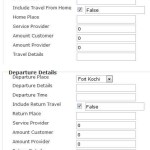Are you taking a cognitive dump on your customers?

Remember the nursery rhyme 3 blind mice?
Three blind mice,
Three blind mice
See how they run,
See how they run!
They all ran after
The farmer’s wife,
She cut off their tails
With a carving knife
Did you ever see
Such a sight in your life
As three blind mice?
What about the “academic” version?
A trio of sightless rodents
A trio of sightless rodents
Observe how they perambulate
Observe how they perambulate
They all pursued the agriculturalist’s spouse,
Who severed their caudal appendages with a carving utensil
Have you previously observed such a phenomenon in your existence
As a trio of sightless rodents?
If you read the academic version, I’ve just taken a cognitive dump on you.
Sounds gross, but that’s not even the worst of it. You may be taking a cognitive dump on each and every one of your customers – and doing it on a regular basis.
It’s a big part of why they leave confused, overwhelmed, and aggravated. Of course they leave without buying anything. They’re not gonna share their email address with people who dump on them and they certainly won’t want them to “follow-up”.
Because cognitive dumps are silent sale killers.
What do I mean when I use the phrase “cognitive dump”?
Cars have a limited amount of fuel. Run out of gas and your car stops moving. Your car’s not broken, but you won’t be going anywhere without fuel. Your customer’s brain works the same way.
Each customer has a mental fuel tank that runs on what Steve Krug calls “goodwill”. Some customers have big fuel tanks while others have small ones. Whenever they run into problems on a website, it drains their fuel tank (by a little or a lot). The more frustrated or overwhelmed they become, the faster their tank runs to empty.
Customers leave when their tank is empty.
Even worse, a single mistake on your part can empty their fuel tank completely. Make the right mistake and they’re gone for good.
A cognitive dump drains your customer’s mental fuel tank.
Little by little it uses up the resources in their tiny tank, to the point where they stop moving through the sales process.
The amount of fuel we have depends on factors like our state of mind, the amount of time we have, and our experiences. If we’re hungry, in a rush or in a bad mood–if we’re not at our best–our fuel tank shrinks.
Profitable websites do one thing well; they conserve their customer’s fuel tank. They do that by making things clear. They do everything they can to avoid making mistakes that frustrate or overwhelm their customers.
But which mistakes drain their fuel tank?
At first glance the list of possibilities seem to come in all shapes and sizes. There are lots of ways to overwhelm and overload your customer. But a closer look at cognitive dumps reveals these mistakes boil down to two basic problems; too much or too little.
Your website has to walk a fine line between too much or too little.
Give too much and you overwhelm them. Once that happens, most people shut down. There’s too much for them to do, so the safest choice for them is to do nothing. Which is typical with website lists, product features and specifications. If it has more technical details than your audience can handle, overload is on it’s way. Ask too many questions, send them to a long wall of text and customers shut down.
Give too little on the other hand, and customers start to drain their own tanks. People often assume the worst when there isn’t enough information. No address or contact information? “I probably can’t trust you.” Not sharing personal details with your customer testimonials? “Well, your testimonials must be fake then.” Giving too little when more is expected raises red flags that drain a customer’s motivation to buy.
Giving too much or too little produces the same end result. A cognitive dump on your customers and a severe limit on their ability or willingness to buy.
And then there’s friction, the other element that limits their willingness to buy.
MECLABS defines friction as:
“a psychological resistance to an element in the sales or sign-up process”
The harder it is to do something on your site the greater the friction. The longer the conversion process, the more confusing the experience, the more friction you create in your customers.
Because friction is also about giving too much or too little.
Let’s say you’re planning your vacation. You’re ready to make your reservations and you’re asked to fill out a form that looks like this.
Are you eager to fill out that monstrosity? If you’re like most people, the answer is no. This would be a problem even if it was for something you really wanted. As a result, there’s instant psychological resistance.
- What if my internet dies in the middle of this and I lose everything I’ve just entered?
- Why do you want so much info from me?
- Ugh, I really don’t have time to sit down and go through this all at once. I’ll do it later.
- What are you going to do with my info?
It’s true that some of these issues crop up regardless, but friction is still the problem in this equation. If it’s confusing, hard or takes time, there’s resistance.
But friction isn’t something you eliminate, it’s something you adjust.
If you’re trying to generate a lot of leads it makes sense to ask for less information. But if you want higher quality leads you ask for more information. Friction is a knob you turn up or down depending on your goals.

You adjust friction. You don’t remove friction.
Getting customers to act is the end goal so you’ll need to accommodate them.
And you accommodate them by doing all sorts of helpful things. Speaking the same language, writing at a comfortable reading level, choosing stories and examples they can relate to, etc. Doing this means you’ll also use your copy, design, images and code to create their ideal habitat.
- Where they have the right amount of information, at the right time.
- Where clarity is a constant.
- Where they aren’t overloaded or constantly bombarded by the messages everyone typically sends.
When you create their ideal habitat you’re focused on giving them the care, guidance and protection they need.
The wrong habitat means you’re constantly taking a cognitive dump on your customers.
When you have the wrong habitat you’ve got the wrong audience, making most of what you say to your customer irrelevant and out of context. When you find yourself in a situation like this everything seems…off.
Like the story of an eager life coach we’ll call Kim.
Kim (not her real name) created a premier course for students graduating from college. Her mission: help college kids find financial stabilty and success after college. Her course was expensive but it definitely worked.
Except for one problem.
Most college kids don’t have any money. At least not the amount she’s asking for. Still, a decent amount of college kids want what she’s offering.
But her habitat is wrong. She made the mistake of creating her product first and finding her ideal customer second. College graduates land on her site where she describes their problems in detail.
“College graduates are loaded down with student loans. Many graduates don’t use their degrees after graduating. And most struggle to find good jobs.”
Naturally, graduates feel pretty anxious after reading that. They want the solution – her online course. Except for the fact that they have no money. The irony here is that graduates would need to be financially stable in order to afford her course on financial stability.
Her sales copy overwhelms students with the magnitude of their problem and her solution is unattainable for most. So students leave her site with an empty tank – anxious, overwhelmed and unfulfilled.
She’s asked the wrong audience for too much. And as a result, she’s taken a cognitive dump on them.

A cognitive dump is painful for you and your customer.
But the cognitive dump has an antidote.
And that antidote is clarity. You get clarity by gaining an in-depth and detailed understanding of your ideal customer. You create clarity by crafting simple, clear messages that are easy to understand.
If you’ve tried to boil your experience down into small, bite size pieces you know how hard that is. But that’s exactly what your customers need. So the question then, is how?
Start with a three step process.
1 Find your ideal customer
Customers are lots of things. They can be amateurs or experts, educated or ignorant, interested or unaware. You’ll need to choose the criteria you’ll use to find your customer, because you’re looking for a real person.
2 Interview your ideal customer
Once you’ve found your ideal customer you need intel. Get a list of their problems. What’s their biggest problem? What would keep them from buying? Can your product or service solve their problems? How? Customers need 9 specific things from your website before they can buy, use this interview to drill as deep as you can.
Got an in-depth understanding of your ideal customer? Awesomesauce, you’re ready to start marketing. Your interview should’ve given you what you need to create content and marketing material. If you’ve done your homework, your content should attract lots of other ideal customers just like them.
3 Get feedback from your ideal customer
Take your content and marketing materials back to your ideal customer. Do they understand it? How do they use it? Where do they get stuck? Is it simple for them to do what you want them to do? Do they understand why they should do it?
Know the kind of questions you need answers to upfront.
If you’re getting a response like “oh that’s nice” or “that’s interesting”, you know–the kind of response that tells you they’re glazing over–you need to try again.
Taking a cognitive dump on your customer is much harder when you understand them. When you take the time to get to know them, you’re aware of their wants and needs, almost like you know what they want before they do.
Well, what if your customers need lots of information?
They might even expect it. Telling the whole story is an important part of the sales process because there’s no way to know which piece of information matters most to each individual customer. So telling the whole story is good. Customers get the information they need, you make a sale, everybody wins.
Unless you try to tell the whole story all at once.
Telling the whole story all a once is overwhelming. Instead of dumping on them, guide them through unfamiliar territory. Give them relevant pieces of information as they need it, step-by-step. Share guarantee, refund and warrantee pages where customers expect to see them. Put product specs on your product pages.
And if you sell something that’s highly technical?
Make it relatable to them. Share stories and anecdotes they’re familiar with. Use simple examples to explain the complex. Add the problem, explaining how your technical solution can solve it. And if your customers aren’t fluent in jargon, it’s a good idea to minimize that.
You know what a trio of sightless rodents means
But 3 blind mice says it best. It’s instant, takes less brain power and conserves mental fuel. Best of all, it avoids the cognitive dump.
How about you? How do you react when a website or marketing piece dumps on you?

